
UD-4 CHEYANNE


|
UD-4 CHEYANNE |
M577 APC |

|
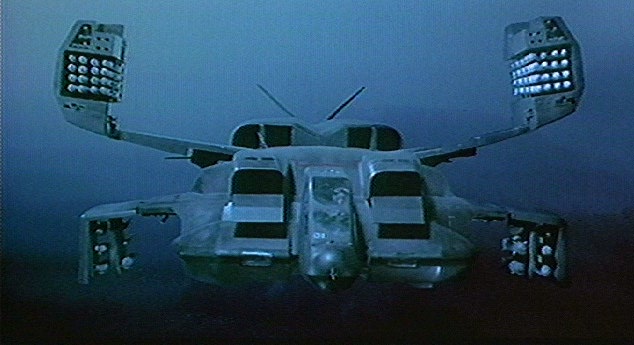 "The guys had a hunnerd differn't names fer
'em. In our platoon we tagged 'em 'Alpha-Bravos'; kinda short fer
'Ass-busters', 'cuz you feel like you've been goosed every time
you make a drop, if y'know what I mean. But if you wuz pinned
down in a hot LZ, then the sight of one o' them mothers buzzing
over the horizon to grease them bandits with rockets was the most
awesome thing in the world." -- Unnamed Marine
"The guys had a hunnerd differn't names fer
'em. In our platoon we tagged 'em 'Alpha-Bravos'; kinda short fer
'Ass-busters', 'cuz you feel like you've been goosed every time
you make a drop, if y'know what I mean. But if you wuz pinned
down in a hot LZ, then the sight of one o' them mothers buzzing
over the horizon to grease them bandits with rockets was the most
awesome thing in the world." -- Unnamed Marine
Airframe
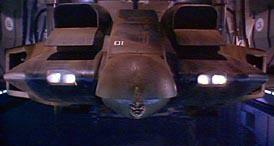
The lifting-body airframe is built around its 103.6 cubic meter internal payload bay,
flanked to the sides and aft by the tri-skid undercarriage. Forward of the payload
space is the cockpit and the mounts for the ramrocket engines and control surfaces.
The principle frame is constructed from superplastic-formed diffusion-bonded metal
matrix composits (MMC). They form a structural web running the length of the fuselage,
encompassing the payload volume.
The UD-4L is crewed by a pilot and Weapons Officer seated in a tandem step configuration
cockpit, connected to the cargo bay by a narrow corridor.
The deck ramp can comfortably carry a fully-crewed M577 APC
(with turrel stowed) or a HALOS stores pallet, and is able to raise the cargo completely
into the payload space from groundlevel. Aft of the payload bay, a step gantry can be
lowered to the port side to allow crew access. Forward of the bay, a small volume
accommodates three seats for passengers and additional crew.
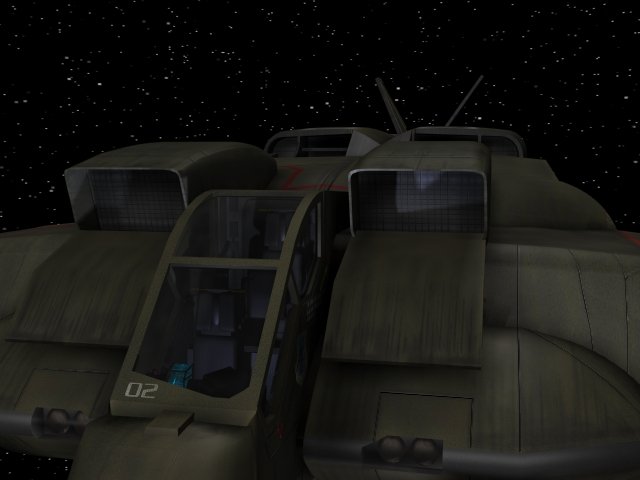
The ramrocket engines are mounted above the main fuselage module, their intakes
accepting the airflow across the upper fuselage. The aft fuselage assembly occupies the
space between the engines and extends rearward to the butterfly contol surfaces. Just aft
of the main engine nozzles are a pair of flush fitted extending airbrake panels which can
also be deployed during re-entry for transonic and hypersonic stability.
The main fuselage also features the mounting poinst for the main weapons pads
and the secondary weapons bay. The main weapons pods are attached to cross-folded
pylons just forward of the ramrocket intakes, which in supersonic flight are stowed flush
against the fuselage sides and the rear of the secondary bays. The pods cannot be deplyed
at speeds above transonic because of the adverse effects of drag and torsion.
Powerplant
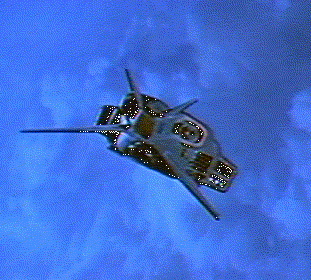 In order to be able to operate in all speed and altitude regimes from vertical take-off
(VTOL) hover to the hypersonic trans-atmopheric, the UD-4 requires two types of powerplant.
The main engines are a pair of Replublic Dynamics TF-900 variable-cycle turbines, each
producing 310 kN static thrust. Each engine has a three-stage fan and seven-stage compressor
each driven by single-stage turbines to produce exceptionally high thrust for low specific
fuel consumption.
In order to be able to operate in all speed and altitude regimes from vertical take-off
(VTOL) hover to the hypersonic trans-atmopheric, the UD-4 requires two types of powerplant.
The main engines are a pair of Replublic Dynamics TF-900 variable-cycle turbines, each
producing 310 kN static thrust. Each engine has a three-stage fan and seven-stage compressor
each driven by single-stage turbines to produce exceptionally high thrust for low specific
fuel consumption.
High-altitude high-speed flight is permitted by the aft TF-220/A-14 ramrockets. The TR-220 is a
combined-cycle engine capable of ramrocket and scramrocket operation from the
supersonic to hypersonic regimes, and rocket power for transatmospheric
operation. In an assult or shuttle operation, a Cheyenne usually has sufficient
fuel to drop from orbit and achieve a low-orbital injection on its return. Descents can be made both
powered or unpowered, dependent on the mission profile, though an injection burn from the rocket engines is usually
required to reach a descent window from orbit.
Stealth Characteristics
As far as is possible, the fuselage has integrated low observable characteristics including
rounded leading surfaces, shielded compressor intakes, and a butterfly tail. Low level
Thermal Baffles have been added to mix cold air with the hot exhaust in order to reduce
the thermal signature, but in the infrared, the Cheyenne is far easier to detect.
Airframe heating is almost impossible to disguise at ranges under 10km, and if the dropship
has just completed a transatmospheric ascent or descent the detection radius can be 30 km
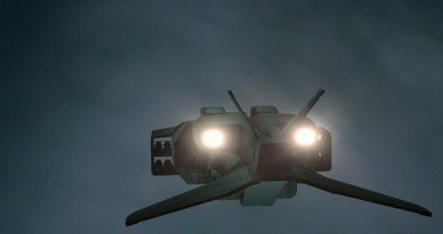 or more in clear skies. A variety of laser-absorbent skin coatings provide some defense
against lidar and laser-targetting systems by attenuating the reflected strength of the
beam. However, the coatings tend to be frequency-specific, they only provide coverage
against a limited number of systems.
or more in clear skies. A variety of laser-absorbent skin coatings provide some defense
against lidar and laser-targetting systems by attenuating the reflected strength of the
beam. However, the coatings tend to be frequency-specific, they only provide coverage
against a limited number of systems.
Defensive Systems
The AN/ALQ-2004E defensive systems consist of four integrated subsystems mounted
throughout the airframe. These are the acquistion jamming suite (AJS), fire control jamming
suite (FCJS), missle defense system (MDS), and the decoy dispenser system (DDS).
The AJS is a defensive jamming system cued by ATLIS to prevent enemy radar from locking up or tracking the dropship. Numberous jamming techniques are available, the particular method being determined by the type of threat and its susceptiblity to different jamming modes.
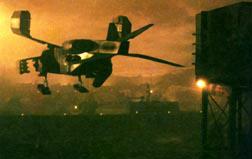 The FCJS is a group of jammers which is cued by either the detection of a hostile
emission or the warning of an incoming threat. Most of the suite's jammers are
mounted internally in the dropship, but several - and many of the jammer
antennae - are contained in a towed unit which can be deployed up to 50 m behind the
dropship. The towed unit is armored and equipped with aerodynamic snub wings to allow
maneuvers up to 100 g.
The FCJS is a group of jammers which is cued by either the detection of a hostile
emission or the warning of an incoming threat. Most of the suite's jammers are
mounted internally in the dropship, but several - and many of the jammer
antennae - are contained in a towed unit which can be deployed up to 50 m behind the
dropship. The towed unit is armored and equipped with aerodynamic snub wings to allow
maneuvers up to 100 g.
The MDS is a point defense system employed against incoming missles in their terminal phase, usually within 1,500 meters. This system is capable of dazzling a missile's oprical/infrared seeker, or feeding false range information to its missile's optical/infrared seeker, or feeding false information to its laser fusing system.
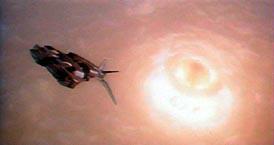 The Lascor ELVIREA II decoy dispenser system (DDS) is a multi-feed rotary launcher capable of firing
conventional flare and chaff cartidges as well as the ALE-106 expendable mini-jammer. It can be
employed either as a deception jammer or an electronic false target generator and has a
secondary role as a decoy for home-on-jam capable missles.
The dispensers are mounted on the towed pod, have 200 tubes for chaff/flares, and weigh a
mere 40 kilograms fully loaded, and require 2 CF to mount on a firmpoint. This of course
counts as a Signature reduction, but only when the pod is extended behind the craft. A pod
costs 2,500
The Lascor ELVIREA II decoy dispenser system (DDS) is a multi-feed rotary launcher capable of firing
conventional flare and chaff cartidges as well as the ALE-106 expendable mini-jammer. It can be
employed either as a deception jammer or an electronic false target generator and has a
secondary role as a decoy for home-on-jam capable missles.
The dispensers are mounted on the towed pod, have 200 tubes for chaff/flares, and weigh a
mere 40 kilograms fully loaded, and require 2 CF to mount on a firmpoint. This of course
counts as a Signature reduction, but only when the pod is extended behind the craft. A pod
costs 2,500
DIMENSIONS
|
The 'L' variant tactical transport carries a wide array of powerful weaponry that can be used
in dedicated support of its troop complement. Two main weapons bays fold out on extened pylons
to deply weapon hardpoints capable of carrying 16 X 150 mm unguided rockets, 6 X 70mm unguided
rockets and 4 X 120 mm guided rockests each. Two secondary bays on the port and starboard side
of the fuselage house a further 12 hardpoints for Air-to-Air and Air-to-Surface missiles.


| ||||||||||||||||||
| Handling | Speed | Accel | Body | Armour | Sig | |||
|---|---|---|---|---|---|---|---|---|
| 5/6 | 2300 | 172 | 8 | 10 | 8(4) | |||
| Autonav | Pilot | Sensor | Cargo | Load | ||||
| 4 | 3 | 8 | 1 | 8793 | ||||
| Seating | 2e, armored | Setup/Breakdown | 20 | |||||
| Entry | 1 + 1h + 1r | Landing/Takeoff | VTOL | |||||
| Fuel | Turbine ( 2500 liters ) | Economy | 0.3 km/liter | |||||
| DP Cost | 41971 | Cost | 69,759,361 ¥ Loaded: 78,942,161 ¥ | |||||
| Chassis | Twin Engine VTOL | Reference | The Shop | |||||
| Engine | Jump Jet / Ramrocket | |||||||
| Features |
Acceleration Increase (Level 122) Increased Cargo Space (CF 616*) Load Increase (Level 904) Speed Increase (Level 1533) Efficiency Increase (Level 40) Signature Improvement (Level 1) Smart Materials Structural Agility (Level 3) Drive-by-Wire (Level 3) Engine Customization Load (Level 6) Secondary Controls Datajack port Rigger Adaptation Remote-Control Interfaces Remote Pilot Advanced Programming (Rating 3) Autonav (Level 4) |
EnviroSeal (gas, overpressurization) Life Support Systems (Man-hours 20) Advanced Passenger Protection Systems Crash Cages ( 0) Standard Armour (Armour 10) Ablative Armor (Level 3) Internal Rocket Mounts (Quantity 4) Turrets, Remote (mini) (Quantity 1) Smartlink Integration Kits (Level 2) Radar-Absorbent Materials (Level 2) Thermal Baffles (Level 1) ECCM (Level 8) ECM (Level 8) ED (Level 2) Chaff/Flares/ECM Pod 9.5m x 4.5m x 2.4m Cargo Bay (3624 CF) |
||||||
| Other Features |
Ruggedness (-2 Stress Modifier)
Complex Chassis (+2 B/R Modifier) Handles Like a Pig (-1 Handling) |
|||||||
| Weapons |
Weapon Vanquisher Minigun 900 round drum MDS Point Defense Laser 16x2 Mk.16 "Banshee" 150mm Rockets 6x2 ZEUS 70mm Rockets 4x2 120mm Ballista II Guided Rockets 3x2 Ares Dragon's Breath Attack AAM 3x2 Mitsubishi-GM Super Bandit AGM |
Type HMG Regular Defense High Explosive Anti-Vehicular Intel: 6 Intel: 9 Intel: 6 |
Load 45 45 10 2304 189.6 22 20 20 |
CF turret 8 5 64 12 6 12 12 |
Damage 10S NA 3L 16D 16D 14D 18D by warhead |
800 ¥ 10,000 ¥ 48,000 ¥ 24,000 ¥ 20,000 ¥ 9.0 mil ¥ 90,000 ¥ |
||
|---|---|---|---|---|---|---|---|---|
 |
Return to Morpheus International
This form created by The Shop, written by
Vehicle design & form modifications by
|  |